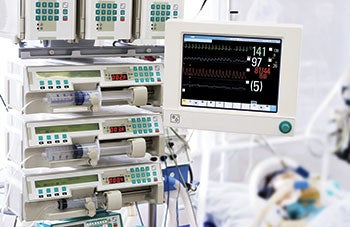ECRI reports medical device alarms remain problem
 |
| PHOTO BY ANDREI MALOV/THINKSTOCK Medical device alarms have topped ECRI’s Top 10 Health Technology Hazards list for four years in a row. |
Hospitals continue to grapple with the complexities of medical device alarms and how caregivers respond to alarms that at times are excessive but at other times require immediate response, according to ECRI Institute, Plymouth Meeting, Pa.
The ongoing issue caused ECRI to put alarm hazards, specifically inadequate alarm configuration policies and practices, first on its 2015 Top 10 Health Technology Hazards list, the fourth year in a row it has topped the list, says Robert Schluth, senior project officer, health devices group at ECRI.
Medical device alarms remain a complicated problem because of the number of alarmed devices in use and various parameters that cause them to go off, Schluth says. The good news is that hospitals continue to make progress with how they configure medical device alarms, he adds.
“We’re aware of facilities that have put together very good programs to make improvements,” Schluth says.
According to ECRI, common problems associated with alarmed devices include:
• Failing to reset the device to the default alarm limits for new patients;
• Choosing inappropriate alarm limits for the specific patient condition;
• Selecting alarm priority levels that do not match the seriousness of the required speed of response.
Failing to correct improper configurations can cause caregivers to become desensitized and experience alarm fatigue, Schluth says.
Actions recommended by ECRI include:
• Defining default parameter alarm settings, including limits and priorities, that reflect the clinical indications and needs of the specific care area;
• Establishing default alarm-volume settings that meet the needs of the specific care area;
• Determining who is authorized to make alarm changes and under what circumstances.
In a related area, ventilator disconnections not caught because of improperly set or missed alarms was No. 5 in ECRI’s top 10 technology hazards list.
Many ventilator models incorporate an automatic alarm specific for circuit disconnections, but the settings cannot be configured by the user. While it provides some protection, it alone should not be relied upon, ECRI says.
A more reliable way to detect disconnections is to verify that user-configurable alarms are properly set and at a volume that caregivers will hear.




